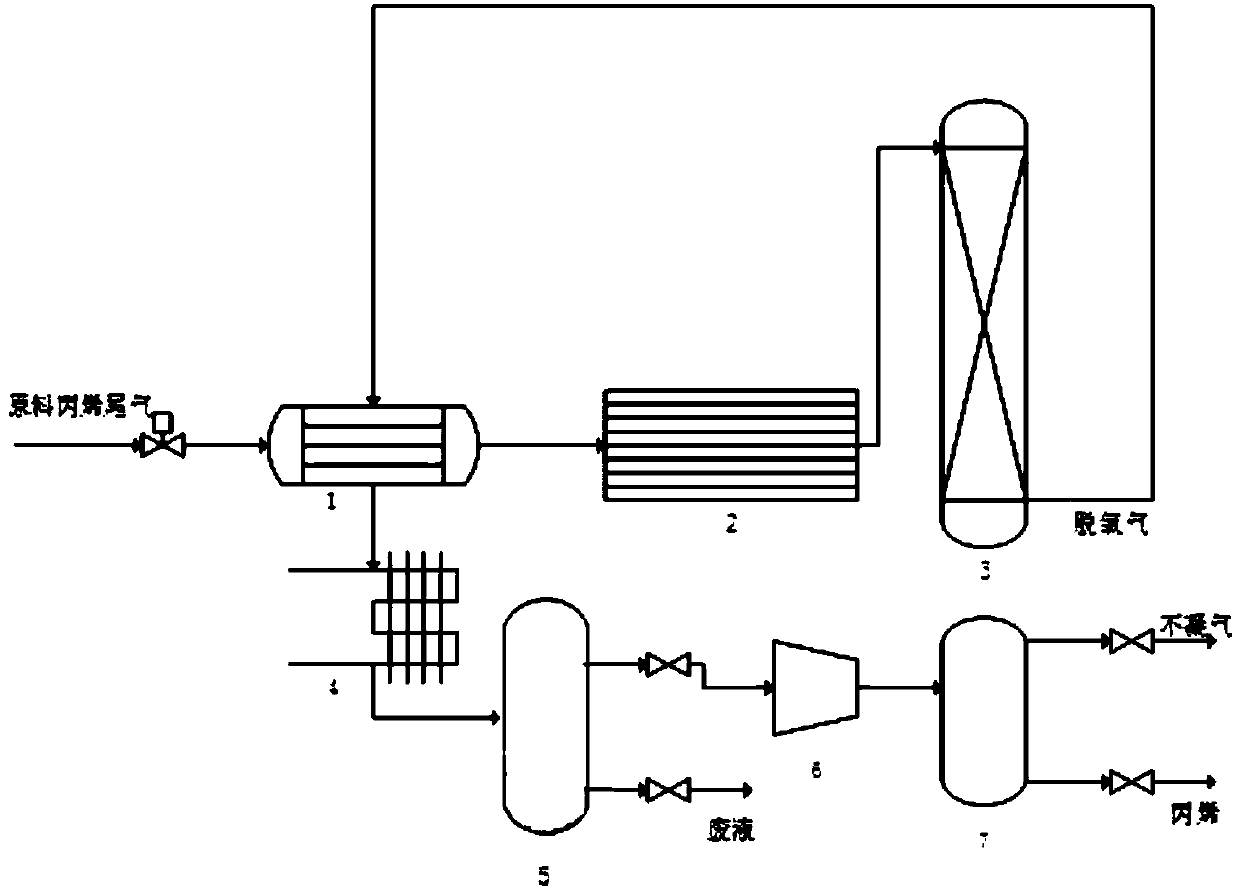Propylene gas catalytic deoxidation device and method
A gas catalysis and reaction device technology, which is applied in chemical instruments and methods, separation methods, chemical industry, etc., can solve the problems of difficult separation of reducing gas, no catalytic deoxidation technology, and high deoxidation temperature of activated carbon, so as to suppress the by-product CO. The effect of generating, suppressing the occurrence of carbon deposition, and strengthening the bearing capacity
- Summary
- Abstract
- Description
- Claims
- Application Information
AI Technical Summary
Problems solved by technology
Method used
Image
Examples
Embodiment 1
[0040] Composition of propylene tail gas: the concentration of oxygen by volume is 5%, the concentration of propylene by volume is 90%, and the concentration of nitrogen is 5%. Reaction pressure 1MPa, reaction space velocity 10000hr -1. The propylene tail gas is at 40°C. After the heat is exchanged to 120°C by the heat exchanger, it enters the deoxygenation reactor, and the outlet temperature of the reaction bed is 280°C. The gas after the deoxygenation reaction exchanges heat with the raw material gas to 80°C, and after being cooled to 20°C by the air condenser, it enters the gas-liquid separation tank to separate the liquid phase generated during the reaction. Gas phase oxygen content 0.1%, CO selectivity 0.4%, CO 2 99% selectivity. The gas phase enters the non-condensable gas separation tower after being boosted by the compressor, the non-condensable gas is separated from the gas phase, and pure propylene is obtained from the liquid phase. Non-condensable gas compositio...
Embodiment 2
[0042] Composition of propylene tail gas: the concentration of oxygen by volume is 5%, the concentration of propylene by volume is 90%, and the concentration of nitrogen is 5%. Reaction pressure 3MPa, reaction space velocity 50000hr -1 . The propylene tail gas is at 40°C. After the heat is exchanged to 180°C by the heat exchanger, it enters the deoxygenation reactor, and the outlet temperature of the reaction bed is 355°C. The gas after the deoxygenation reaction exchanges heat with the raw material gas to 100°C, and after being cooled to 20°C by the air condenser, it enters the gas-liquid separation tank to separate the liquid phase generated during the reaction. Gas phase oxygen content 0.18%, CO selectivity 0.48%, CO 2 Selectivity 98.05%. The gas phase enters the non-condensable gas separation tower after being boosted by the compressor, the non-condensable gas is separated from the gas phase, and pure propylene is obtained from the liquid phase. Non-condensable gas com...
Embodiment 3
[0044] The composition of the propylene tail gas: the concentration of oxygen by volume is 1%, the concentration of propylene by volume is 96%, and the concentration of nitrogen is 4%. Reaction pressure 2MPa, reaction space velocity 15000hr -1 . The propylene tail gas is at 40°C. After the heat is exchanged to 160°C by the heat exchanger, it enters the deoxygenation reactor, and the outlet temperature of the reaction bed is 210°C. The gas after the deoxygenation reaction exchanges heat with the raw material gas to 60°C, and after being cooled to 20°C by the air condenser, it enters the gas-liquid separation tank to separate the liquid phase generated during the reaction. Gas phase oxygen content 0.08%, CO selectivity 0.02%, CO 2 Selectivity 99.5%. The gas phase enters the non-condensable gas separation tower after being boosted by the compressor, the non-condensable gas is separated from the gas phase, and pure propylene is obtained from the liquid phase. Composition of no...
PUM
 Login to View More
Login to View More Abstract
Description
Claims
Application Information
 Login to View More
Login to View More - R&D
- Intellectual Property
- Life Sciences
- Materials
- Tech Scout
- Unparalleled Data Quality
- Higher Quality Content
- 60% Fewer Hallucinations
Browse by: Latest US Patents, China's latest patents, Technical Efficacy Thesaurus, Application Domain, Technology Topic, Popular Technical Reports.
© 2025 PatSnap. All rights reserved.Legal|Privacy policy|Modern Slavery Act Transparency Statement|Sitemap|About US| Contact US: help@patsnap.com

